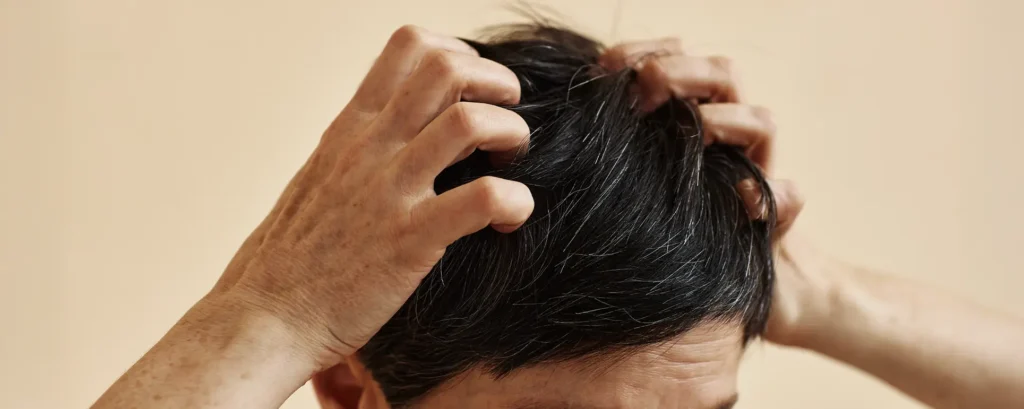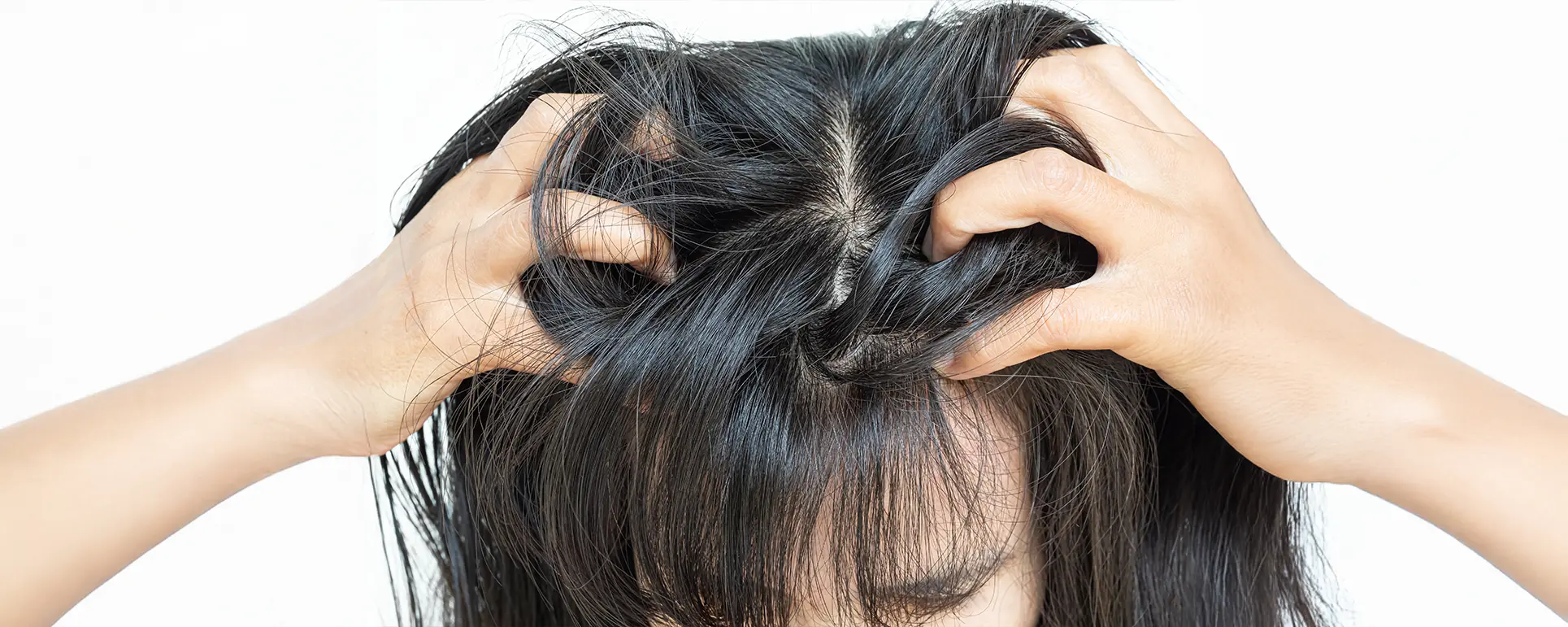Have you ever felt tenderness or soreness on your scalp especially when brushing, moving, or tying your hair?
It might feel like a dull ache, a burning sensation, or sharp discomfort when your hair moves even slightly. You might notice it’s worse after keeping your hair tied up, or when your scalp feels dry, itchy, or irritated.
While occasional scalp sensitivity is normal, persistent pain or tenderness can indicate an underlying issue from inflammation and nerve irritation to dermatological conditions like seborrhoeic dermatitis or folliculitis.
In this guide, we’ll explore what might be causing your sore scalp, how dermatologists diagnose it, and what treatments can help you feel relief quickly and safely.
What Does It Mean When Your Scalp Hurts?

Scalp pain or tenderness, medically known as trichodynia, refers to discomfort on the skin of the scalp rather than within the hair itself.
You might feel:
- Pain when brushing or washing your hair
- Tenderness around the crown or temples
- A burning, stinging, or pulling sensation
- Discomfort when moving your hair or touching your scalp
Because hair has no nerves, the pain originates in the skin, muscles, or nerves beneath the scalp. The cause can range from something as simple as tension to a more complex inflammatory or neurological condition.
Common Causes of Scalp Pain
1. Tension or Tight Hairstyles (Traction Alopecia)
Wearing tight ponytails, braids, buns, or extensions can pull on hair follicles, leading to soreness and inflammation.
This condition, known as traction alopecia, doesn’t just cause pain over time, it can damage follicles and contribute to hair loss.
Symptoms:
- Scalp tenderness or throbbing
- Small bumps around the hairline
- Hair breakage or thinning in areas under tension
What helps:
- Loosening hairstyles
- Alternating hair positions daily
- Using gentle, wide-tooth combs
If pain persists or hair loss occurs, consult a dermatologist for evaluation and early intervention.
2. Seborrhoeic Dermatitis (Dandruff Inflammation)
A sore or itchy scalp may also be due to seborrhoeic dermatitis a common inflammatory condition caused by an overgrowth of natural yeast (Malassezia) and excess oil production.
Symptoms:
- Greasy flakes or yellowish scales
- Itching and redness
- Tenderness, especially after scratching
- Worsening in cold or dry weather
Treatment:
- Medicated shampoos (ketoconazole, selenium sulphide, or zinc pyrithione)
- Topical steroid lotions or antifungal creams
- Gentle cleansing to prevent buildup
This condition is chronic but manageable with proper care.
3. Folliculitis (Inflamed Hair Follicles)
When hair follicles become infected or inflamed, they can cause painful red bumps that resemble pimples. This condition is called folliculitis.
Causes:
- Bacterial infection (often Staphylococcus aureus)
- Friction from hats or helmets
- Sweat buildup or occlusive hair products
Symptoms:
- Localised soreness
- Small pustules or scabs around hair roots
- Mild itching or burning
Treatment:
- Antibacterial washes or topical antibiotics
- Avoiding occlusive oils or tight headwear
- For severe cases, oral antibiotics prescribed by a dermatologist
4. Scalp Psoriasis
Psoriasis is an autoimmune condition that speeds up skin cell turnover, leading to thick, scaly patches that can feel painful or tight.
Symptoms:
- White or silvery scales on the scalp
- Flaky buildup near the hairline
- Tenderness, itching, and burning
Treatment:
- Coal tar or salicylic acid shampoos
- Topical steroids or vitamin D analogues
- Light therapy for resistant cases
Early treatment can reduce inflammation and discomfort while preventing flare-ups.
5. Nerve Sensitivity (Trichodynia)
Sometimes, scalp pain occurs without visible inflammation. This is known as trichodynia or “scalp dysesthesia”.
It’s often linked to nerve sensitivity, stress, or even psychological tension. People with hair loss conditions like telogen effluvium may also experience it.
Symptoms:
- Burning, tingling, or prickling sensation
- Pain when hair moves, even gently
- Sensitivity with no visible rash
Possible causes include:
- Stress or anxiety
- Hormonal fluctuations
- Vitamin deficiencies
- Scalp nerve inflammation
Treatment:
- Stress reduction techniques
- Scalp massages with mild oils
- Prescription creams or oral medications to calm nerve activity
6. Contact Dermatitis (Allergic Reaction)
Your scalp might hurt if it’s reacting to a new shampoo, dye, or styling product.
Symptoms:
- Sudden itching or burning
- Redness and swelling
- Flaky or crusty patches
- Soreness when moving your hair
If you recently changed hair products or used at-home colouring kits, stop using them immediately. Your dermatologist can perform patch testing to identify allergens and recommend safe alternatives.
7. Sunburn or Heat Damage
If your scalp is exposed to the sun for extended periods particularly with thinning hair UV rays can cause sunburn, leading to tenderness and peeling.
Symptoms:
- Red, hot, or flaky skin
- Pain when brushing or moving hair
- Temporary hair shedding in severe burns
Treatment:
- Cool compresses and aloe vera
- Fragrance-free moisturiser
- Broad-spectrum sunscreen or hats for prevention
8. Infections (Fungal or Bacterial)
Fungal infections like tinea capitis (scalp ringworm) can cause patchy soreness and hair loss. Bacterial infections may also lead to follicular inflammation.
Symptoms:
- Circular bald patches with redness
- Oozing or crusty sores
- Painful scalp swelling
These infections require medical treatment usually antifungal or antibiotic therapy prescribed by a dermatologist.
9. Migraines or Muscle Tension
Interestingly, scalp tenderness isn’t always dermatological. Migraines or muscle tension headaches can cause referred pain to the scalp.
Symptoms:
- Throbbing pain at temples or crown
- Tight, band-like pressure
- Pain worsens with touch or movement
Gentle stretching, relaxation exercises, and adequate hydration may help. If symptoms are frequent, speak to your GP or a specialist for further evaluation.
10. Hormonal or Nutritional Factors
Deficiencies in nutrients like iron, vitamin D, and B12, or hormonal changes (as in menopause or thyroid imbalance), can make your scalp more sensitive.
These imbalances can weaken hair follicles, making the scalp feel sore or tender.
A dermatologist may recommend blood tests to rule out underlying deficiencies or endocrine issues contributing to your discomfort.
When to See a Dermatologist

Occasional scalp soreness after a tight hairstyle or product use isn’t unusual.
However, you should see a dermatologist if:
- The pain persists for more than a few days
- You notice hair loss, scabbing, or bleeding
- The scalp looks inflamed or infected
- Over-the-counter treatments haven’t helped
- You experience burning without visible irritation
Dermatologists can identify the root cause through:
- Visual examination
- Dermatoscopy (magnified scalp inspection)
- Swab or culture tests for infection
- Patch testing for allergies
- Scalp biopsy in rare or unclear cases
How a Dermatologist Treats Scalp Pain
The right treatment depends on the diagnosis, but most approaches aim to reduce inflammation, repair the scalp barrier, and relieve discomfort.
1. Topical Medications
- Steroid lotions or foams to calm inflammation
- Antifungal or antibiotic creams for infections
- Calming serums for sensitive scalp syndromes
2. Medicated Shampoos
- Antifungal shampoos for dandruff or seborrhoeic dermatitis
- Salicylic acid or tar-based shampoos for psoriasis
- Mild, sulphate-free cleansers for sensitive scalps
3. Oral Medications
- Antibiotics for folliculitis or bacterial infections
- Antifungals for ringworm or seborrhoeic dermatitis
- Anti-inflammatory or neuropathic pain medications (gabapentin, amitriptyline) for trichodynia
4. Procedural Treatments
- LED light therapy for inflammation
- Corticosteroid injections for localised pain or psoriasis patches
5. Lifestyle & Home Adjustments
- Avoid heat styling and harsh chemicals
- Massage scalp gently with fingertips
- Manage stress through relaxation techniques
- Eat a balanced diet rich in zinc, biotin, and omega-3
Simple At-Home Remedies for a Sore Scalp
If your scalp feels sore or irritated, it can be uncomfortable and distracting. While you’re waiting for a proper diagnosis or looking to complement medical care, there are some gentle home remedies you can try.
Aloe vera gel is a great option it soothes irritation and keeps your scalp moisturised, helping it feel calmer. A cool compress can also bring relief by reducing inflammation and easing tenderness.
If your scalp feels dry, using coconut or argan oil can help restore moisture and support its natural barrier. For extra care, diluted tea tree oil may help, thanks to its antimicrobial and anti-inflammatory properties but always make sure it’s diluted first.
A gentle scalp massage can improve blood flow and help you relax, while wearing loose hairstyles reduces tension and prevents extra irritation.
Always remember to patch-test any natural oils before using them broadly, so you can avoid reactions. These simple steps can help keep your scalp comfortable while you follow any medical advice.
How to Prevent Scalp Pain
Once your scalp feels better, follow these steps to prevent future discomfort:
1. Avoid tight hairstyles or wearing the same style daily.
2. Wash hair regularly to remove buildup without over-drying.
3. Use lukewarm water, not hot, when washing.
4. Choose mild shampoos free of sulphates and alcohol.
5. Replace hairbrushes regularly and clean them to remove residue.
6. Manage stress, which can trigger nerve-based scalp pain.
7. Protect your scalp from the sun with hats or SPF sprays.
Consistency in scalp care helps reduce recurrences significantly.
Is Scalp Pain a Sign of Hair Loss?
Not always but sometimes.
In conditions like telogen effluvium (stress-induced shedding) or traction alopecia, scalp pain or burning may precede visible thinning.
If you notice more hair in your brush, on your pillow, or during showers, it’s best to get checked early. A dermatologist can detect early hair loss patterns and recommend treatments like minoxidil, platelet-rich plasma (PRP), or scalp therapies.
Myths About Scalp Pain
Let’s clear up a few misconceptions:
Myth 1: Scalp pain means your hair is dirty.
Not true many cases are due to inflammation, not hygiene.
Myth 2: It will go away on its own.
While temporary soreness can fade, chronic discomfort needs medical evaluation.
Myth 3: Using more oil always helps.
Over-oiling can clog follicles and worsen inflammation if infection is present.
Myth 4: Hair dye burning is normal.
Persistent burning indicates an allergic reaction stop use immediately.
Real Patient Scenario
At the London Dermatology Centre, a 32-year-old woman visited with scalp tenderness that worsened when she undid her ponytail. Examination revealed early traction alopecia and mild seborrhoeic dermatitis.
After treatment with a mild corticosteroid lotion and antifungal shampoo, along with instructions to loosen her hairstyles, her scalp sensitivity disappeared within two weeks.
This case highlights how early diagnosis and lifestyle adjustment can reverse discomfort before lasting damage occurs.
When Scalp Pain Is a Sign of Something Else
Sometimes, scalp pain is part of a wider systemic condition, such as:
- Fibromyalgia (chronic pain syndrome)
- Shingles (Herpes zoster) affecting scalp nerves
- Temporal arteritis in older adults (requires urgent attention)
If pain comes with symptoms like fever, headache, vision changes, or swelling, seek medical help immediately.
FAQs:
1. Why does my scalp hurt when I brush or move my hair?
Scalp pain during brushing or hair movement usually stems from irritation or inflammation of the scalp tissue, rather than the hair itself. The skin, muscles, and nerve endings beneath the hair can become sensitive due to tension, infections, or inflammatory conditions like seborrhoeic dermatitis. Even mild stress or tight hairstyles can aggravate nerve endings, causing discomfort that feels sharp, burning, or throbbing.
2. Can tight hairstyles really cause long-term scalp pain?
Yes, consistently wearing hairstyles that pull on your hair, such as ponytails, braids, buns, or extensions, can lead to a condition called traction alopecia. Over time, the constant tension inflames hair follicles and may cause tenderness. If not addressed, this can contribute to hair thinning or breakage. Loosening hairstyles and alternating hair positions daily are crucial steps to reduce strain on the scalp and prevent lasting damage.
3. Is scalp pain always related to hair loss?
Not necessarily. While scalp tenderness can sometimes precede hair shedding in conditions like telogen effluvium or traction alopecia, many people experience scalp discomfort without any noticeable hair loss. In these cases, pain may result from nerve sensitivity, inflammation, or dermatological issues rather than follicle damage.
4. Could stress be causing my scalp to hurt?
Absolutely. Stress can increase scalp sensitivity by affecting nerve function and blood flow in the skin. Trichodynia, or scalp dysesthesia, is a condition where the scalp feels painful or burning without visible inflammation, often triggered by psychological tension. Relaxation techniques, gentle scalp massages, and stress management strategies can help reduce this type of nerve-related discomfort.
5. How do dermatologists determine the cause of scalp pain?
Dermatologists assess scalp pain through a combination of visual examination, magnified inspection with a dermatoscope, and, if necessary, swab or culture tests to identify infections. They may also perform patch testing to uncover allergic reactions or, in rare cases, a scalp biopsy to examine underlying tissue. This thorough approach allows them to pinpoint whether the pain is caused by inflammation, infection, nerve sensitivity, or an underlying systemic condition.
6. Can dandruff or seborrhoeic dermatitis cause my scalp to hurt?
Yes, seborrhoeic dermatitis can lead to tenderness and soreness because the overproduction of oil and the growth of Malassezia yeast trigger inflammation. This can result in redness, itching, and a burning sensation, especially after scratching or during dry, cold weather. Medicated shampoos, gentle cleansing, and anti-inflammatory topical treatments often manage symptoms effectively and relieve discomfort.
7. Is it possible for my scalp to hurt due to a sunburn or heat exposure?
Definitely. The scalp is susceptible to sunburn, particularly if the hair is thin or parted, exposing the skin to UV rays. Sunburned scalp tissue becomes red, hot, and sensitive, and moving or brushing hair can be painful. Using cool compresses, moisturisers, and protective headwear or sunscreen can help soothe irritation and prevent further damage.
8. Can infections make my scalp sore?
Both fungal and bacterial infections can cause localized pain on the scalp. Fungal infections like tinea capitis create patchy bald areas with redness, while bacterial folliculitis presents as inflamed, painful bumps around hair follicles. These infections require medical treatment, often in the form of antifungal or antibiotic medications, to clear the infection and alleviate the associated discomfort.
9. Are there lifestyle changes that can prevent scalp pain?
Yes, regular hair and scalp care can reduce the risk of recurrent discomfort. Avoiding tight hairstyles, washing hair with lukewarm water and mild shampoos, keeping hairbrushes clean, and protecting the scalp from sun exposure all contribute to maintaining a healthy scalp. Managing stress and maintaining a balanced diet rich in essential vitamins and minerals can also prevent nerve-related sensitivity and inflammation.
10. When should I seek urgent medical attention for scalp pain?
Immediate consultation with a healthcare professional is necessary if scalp pain is accompanied by fever, severe redness, swelling, oozing sores, sudden hair loss, or neurological symptoms like vision changes or intense headaches. These signs may indicate infections, shingles, or other systemic conditions requiring prompt intervention. Even if the pain is persistent without these alarming symptoms, visiting a dermatologist is advisable to prevent worsening or long-term issues.
Final Thought: Relieving and Preventing Scalp Pain
Scalp discomfort can be frustrating, but with proper care and early attention, most causes of scalp pain are manageable. Whether it’s due to tight hairstyles, inflammation, nerve sensitivity, or underlying dermatological conditions, timely intervention can prevent further complications and reduce discomfort.
You can book a consultation with one of our dermatologists by contacting us at the London Dermatology Centre. Our dermatologist will assess your scalp and recommend a personalised treatment plan to relieve discomfort and prevent future pain. Simple lifestyle adjustments, gentle hair care routines, and medical treatments when necessary can help you keep your scalp healthy, comfortable, and pain-free.
References:
1. Trüeb, R.M., 2021. ‘Trichodynia revisited’. Dermatology and Therapy, 11(1), pp. 1-10. Available at: https://pmc.ncbi.nlm.nih.gov/articles/PMC8613582/
2. Clark, G.W., 2015. ‘Diagnosis and treatment of seborrheic dermatitis’. American Family Physician, 91(3), pp. 185-190. Available at: https://www.aafp.org/pubs/afp/issues/2015/0201/p185.html
3. Souza, E.N., 2023. ‘Sensitive scalp and trichodynia: Epidemiology and clinical manifestations’. Skin and Aging Dermatology, 9(6), pp. 407-413. Available at: https://pubmed.ncbi.nlm.nih.gov/38058545/
4. Toscani, M., Fino, P., 2023. ‘Scalp pain: A review of pathophysiology and management’. Journal of Clinical and Aesthetic Dermatology, 16(5), pp. 28–34. Available at: https://www.ncbi.nlm.nih.gov/pmc/articles/PMC8613582/
5. Lugović-Mihić L, Barisić F, Bulat V, et al. Differential Diagnosis of the Scalp Hair Folliculitis. Acta Clin Croat. 2011;50(3):395-402. Available at: https://pubmed.ncbi.nlm.nih.gov/22384776/
